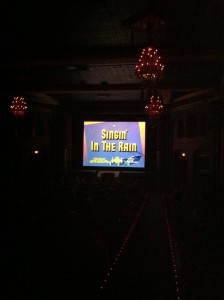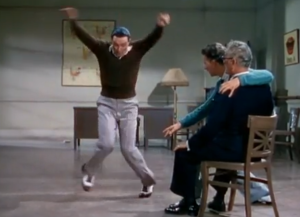 Singin’ in the Rain, 1952. Directed by Gene Kelly and Stanley Donen, written by Betty Comden and Adolph Green. Starring Gene Kelly, Jean Hagen, Donald O’Connor, Debbie Reynolds, Cyd Charisse, and Millard Mitchell, who still reminds me of my Grandpa Schilling.
Singin’ in the Rain, 1952. Directed by Gene Kelly and Stanley Donen, written by Betty Comden and Adolph Green. Starring Gene Kelly, Jean Hagen, Donald O’Connor, Debbie Reynolds, Cyd Charisse, and Millard Mitchell, who still reminds me of my Grandpa Schilling.
“Kids…,” said Irving [‘Swifty’ Lazar, their agent], “My suggestion is you write ‘Singin’ in the Rain’ at the top of the page, followed by ‘Fade-in’, and don’t stop until you come to ‘That’s all, folks.’”
So we began working on Singin’ in the Rain like rats trapped in a burning barn… –Betty Comden and Adolph Green
There’s a fantasy I like to indulge in now and again, in which a person, usually a young person, maybe two, maybe a young couple madly in love or in the first bloom of a relationship, walk by a gorgeous movie theater like the Heights Theater and say “maybe we should catch a show?” Shrugging, barely bothering to see what’s playing, they buy a ticket. “Singin’ in the Rain,” the young woman remarks. Neither of them have seen it, but both are intrigued.
Maybe the guy in question is now a bit grumpy. He wanted Iron Man or The Fast and the Furious 4, 5, or 6. But he’s still a gentleman at this point in their love affair, and concedes to this flick that’s as old as his grandmother.
You see where this is going. They are, in my little fantasy, enthralled. Amazed. They laugh, and weep from laughter, her at “Make ‘Em Laugh” and him when Lena Lamont says “I make more than Calvin Coolidge… put together!” (I don’t know, maybe he’s a history major.) They grip each other’s arms, they marvel at Donald O’Connor, they wonder “did people really dress that way?”, they both go “whoa!” at Cyd Charisse’s long, green-stocking’d legs, and of course, they reach that state of cinematic arrest, when their laughter abates, their mouths drop open ever so slightly and, well, you know, this happens…
The video cannot be shown at the moment. Please try again later.
Let the stormy clouds chase everyone from the place…
I like to imagine that later, secretly, when our heroes are somewhere private, on a rainy day, they recall Singin’, and spin and splash and become, for only a moment, Gene Kelly. Singin’ knows that we all deserve to be Kelly on a rainy, miserable day.
Now, if you’re familiar with the Heights, it’s not really located in an area where a couple might just be wandering in the early stages of their relationship, nor do young couples typically just swerve into a movie house to coincidentally see the greatest motion picture ever made. And last evening they couldn’t even if they wanted to: my wife and I were one of the lucky ones, with tickets to the sold out show. But I like this fantasy, because Singin’ in the Rain is the product of a happy accident itself, and probably couldn’t have been made were it not for being the fruit of a frustrated, put-upon pair of screenwriters.
Betty Comden and Adolph Green wrote Broadway musicals, and their success (with the hit On the Town), meant a sweet contract with MGM. They were attached to what was called The Freed Unit, run by one Arthur Freed, a songwriter and now producer who was pumping out great musicals by the bushel basket. Told by cable to rush out to Hollywood from New York, they boarded a train and, three or four days later, arrived at the MGM studios to find it deserted. Apparently, it was a “Decoration Day” holiday, whatever the hell that is (and this story comes from Comden and Green’s introduction in the Singin’ in the Rain script), so they sat and waited for six days.
So, to start this tale, our screenwriters are pissed. Then, when Arthur Freed returns, he blithely tells them, “Kids!” (they say he called everyone ‘kid’, but from the quote up top, apparently their agent did as well.) “Kids, you need to write a musical using all the songs I wrote with Nacio Herb Brown and call it Singin’ in the Rain.” That didn’t sit well. They had been told that their contract stated explicitly that they would only write scripts to movies based on the works of great songwriters: Gershwin, Berlin, Porter, etc. Not Nacio Herb Brown and Arthur Freed. “Ha!” Freed laughed, in a supposedly friendly way. “Get to work!” Turns out that wasn’t in the contract anywhere.
Disgruntled, probably more frustrated than they acknowledge in these later reminiscences (they admit to ‘going on strike for two weeks’ over this issue, not something you do with a smile and tap dance), they set to work. And what work it was!
What’s intriguing to me is that, faced with this ‘mediocre’ catalogue of songs, baffled by what kind of story they could tell, bitter over their treatment by Hollywood (and Freed specifically), yet realizing exactly what kind of confection the MGM factory manufactured and figuring they really ought to do their best, Comden and Green came up with this lovely masterpiece.
Sequestered away in a near-deserted mansion owned by Marie Prevost, a silent film star long faded, they put together four different ideas for a story, a bunch of gags surrounding the songs, and, believing they had failed, let Comden’s husband read it, ready to hear the worst. Instead, he laughed. A lot. And when Gene Kelly and Stanley Donen were brought in on the project, again they expected rejection. Kelly and Donen loved it, and they helped shape the thing–keeping all four story lines–and there you go.
But look at the detail! Marvel at the insanity! It is clear that everyone involved both loved and hated Hollywood, but this is the rare case where love wins out and the cynicism is kept at bay, seasoning this stock like a pinch of black pepper. Kelly’s Don Lockwood nearly torn to pieces by his “adoring” crowd is right out Nathaniel West’s Day of the Locust, perhaps the bitterest draught ever concocted about the movie industry. Yet that scene propels our movie forward, forces the love interests together. The horror becomes joy.
Clearly, someone, either Donen and Kelly or Comden and Green, had great affection for the old timers who functioned in the background of the industry. Consider: it would’ve been very easy to signal the studio’s transition to talking films by having studio head R. F. Simpson (Millard Mitchell) pull the plug on a silent production and simply announce that talking pictures are all the rage. In fact, he does this later. We don’t really need an explanation for what talking film is like, do we? And yet, we get this inordinately bizarre demonstration by a man who sounds like Vincent Price and could use some serious dental work:
The video cannot be shown at the moment. Please try again later.
I like to think that, faced with making this movie they didn’t want to touch, suddenly given the talents they were given, everyone just had a blast, thinking, Let’s just have some God damned fun! Much as I enjoy An American in Paris, that was a film that also had to prove itself to the ghost of George Gershwin, widely regarded as an American icon. Singin’ had to be fun because while they were working on it, they needed to lift their own spirits. In not having to prove anything, they proved that even silly songs make a great musical. Even if they didn’t initially believe that themselves.
Prior to the show last night, we were treated to an introduction by film historian Bob DeFlores, who screened this lovely little outtake of Debbie Reynolds singing “You Are My Lucky Star”:
The video cannot be shown at the moment. Please try again later.
I have long had a theory about Singin’ in the Rain that I believe is borne out by this clip. The costumes in this film are important–they’re ridiculous, especially in 1952, that grey flannel suit era. Like The Wedding Singer a few years back, part of the point of Singin’ is to show how extravagant that era’s outfits were–and here, Reynolds saying “You looked so dazzling in your green knickers, yellow sweater and orange beret…” proves that theory, as does terms like “The Cat’s Meow” line from the “Dream of You” sequence at the Coconut Grove. The 20s were ripe for send-up, and they’re sent up here, but good.
But it wasn’t enough to simply make fun of an era, to make fun of Hollywood, to burst those bubbles. Singin’, which began under duress, eventually gives way to brilliance. If you notice, the extravagance of the outfits at the start gives way to more conservative collars and more grays and browns. The weirdness of that old man introducing sound to a stunned audience and especially the loony “Beautiful Girl” are eventually set aside as the songs and dances take on more emotional weight, and more skill.
I think Singin’ works so well because, well, because it’s honest. It’s not just smiles and sunshine, there’s long hours working, frustration, setbacks, friendships and affection. There’s parody, but respect leavens it, makes it feel genuine.
Jean Hagen is part of this allure. The Lena Lamont character is essential to the plot, as she works as the sole impediment to every dream. But to make her truly evil would unbalance this delicate film: Hagen may have put in the best performance in Singin’ in the Rain. Set aside her incredible vocal work–in real life she sounds nothing like her character–but she brings just the right mix of vulnerability, stupidity, and cunning to the role. We can’t help but like her in the early going, seeing her bound to a sound cable and then yanked, ass over teakettle, by the studio head in one of the many great scenes. Yes, she got Debbie Reynolds’ Kathy fired, but notice we don’t actually see her doing that–what we see is a hilarious goofball who often has the best lines. Like most people, even those we dislike, they’re still human, still people. Until the end, when it’s necessary to wrap this up and get Lamont out of the picture, Hagen never lets us forget her character’s humanity.
This is one of the elements that helps to create the warm fantasy that our movies were made by great buzzing hives of happy people, actors and soundmen and directors and producers, who worked and bickered and had fun from sunup to sundown in warm weather. Good people, mediocre people, people.
But what really makes the movie are the dances, and especially the eponymous twirl in the rain. I’ve written of this before, but critic Will Friedwald, in his book about Frank Sinatra, The Song is You, notes that one of the things that makes Sinatra so appealing is that his range was limited. Because of this, everyone can sing along with Frank.
This conduit is incredibly important. Look at one of my favorite scenes, “Moses Supposes”, featuring the only song written for the movie:
The video cannot be shown at the moment. Please try again later.
So amazing. I love tap dance, I love this song, love the way both men highlight the other, gripping the poor vocal instructor’s arm and pointing at the amazing footwork of the other dancer, urging him (us!) to watch! Watch! WATCH! That’s beautiful.
But we can’t dance like that. And just as we love to tell the jokes of a comedian we have just witnessed, sing to the radio, or tell the stories that have moved us to others who have not heard them, so, too, do we need a dance that we can perform, can mimick.
We get it in Kelly’s “Rain” sequence. What I’m about to suggest I never noticed before last night–watch the scene again. For starters, I’ve always loved how Kelly, unlike, say, Fred Astaire, works horizontally, as if he’s fighting the same gravity that keeps us all tethered to this thick earth. Astaire seems to float; Kelly muscles his way up things, bends down and at times backwards, as if he’s reaching toward the core of the planet. He is as bound to this spinning ball as we are.
Here, he uses water and height to brilliant effect, tapping his way through puddles, using props (that umbrella and his hat!), and even people–the couple rushing to a dry apartment get a sweet little shake of his hat (which also exposes his head to the elements.) Now, look at that scene again:
The video cannot be shown at the moment. Please try again later.
This is it. Without question, this is easily the simplest dance (deceptively so, I realize) of the entire picture. Anyone can make those great loping strides and twirl an umbrella, we can set our feet apart and sway with our umbrella, can stand under a spigot gushing water smiling like a holy idiot and, best of all, when the camera shoots heavenward to see Kelly leap around the street, we, too, can splash, childlike, in puddles.
This sequence is the gift that great movies often forget: the gift of entrance. Here, Gene Kelly allows us into Singin’ in the Rain. And for that, we are forever grateful.
I don’t know that it makes sense to suggest that the happy accident that became perhaps my favorite movie means that we should all look for accidents. It is certainly a lesson in making the most of a bad situation. There is a secret here, something that infected everyone involved in the movie, an infectious joy that worms its way into everyone who watches Singin’ in the Rain. Perhaps that’s why I always try to imagine people seeing the movie for the first time, emerging stunned, trying to be Gene Kelly when crushing reality rains down hard. Forced to make a movie that they didn’t want to touch, Comden and Green gave us Singin’ in the Rain. How can we ever repay them?


The only problem with already loving this film is that I’ll never be able to live out your fantasy of watching it for the first time.
What a great, insightful commentary–thank you! Watching this movie on the big screen at the Heights, I was struck by the detail and care put into the sets, too, something I think it’s easy to miss when you’ve watched the movie on a computer screen, which is where I’ve mostly seen it (I did see one showing at the Oak Street years and years ago, a double feature with The Wizard of Oz, which was BLISS!). So fun to be able to clap at the dance numbers with other admirers, too–it drives home that these were real people working their arses off to perform us. Seeing the movie on a screen that has a stage and a curtain made it feel more like a “live” performance. So cool.